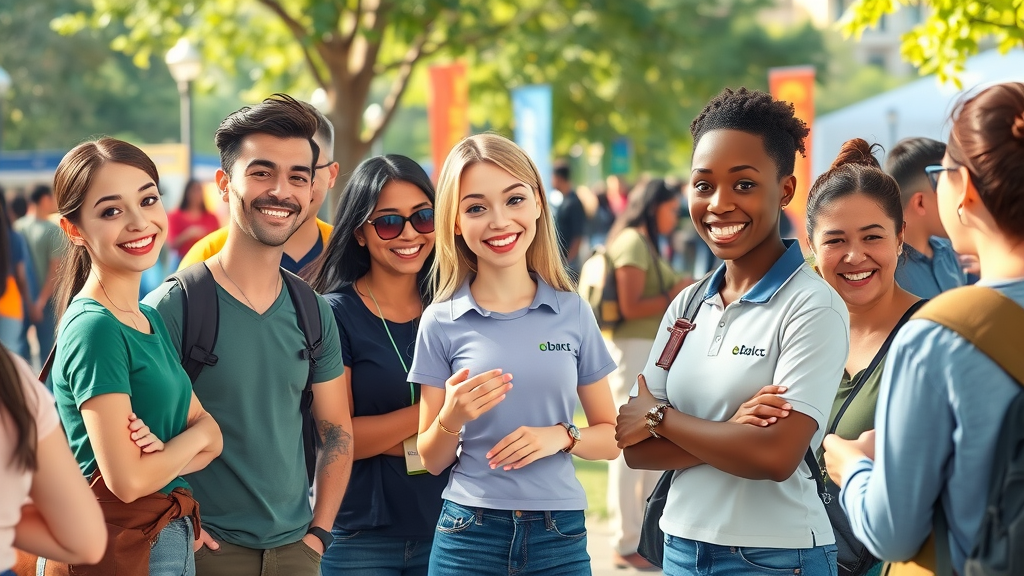
Did you know that volunteers contribute an estimated $200 billion worth of services annually to U.S. nonprofit organizations? This incredible figure highlights both the value and power of volunteers in driving nonprofit missions forward. Yet, managing volunteers effectively and keeping them engaged isn’t always straightforward. In this guide, you’ll discover detailed strategies, practical tips, and best practices for mastering volunteer management and engagement for nonprofits, empowering you to maximize impact and unlock lasting success.
A Startling Look at Volunteer Management and Engagement for Nonprofits
"Volunteers contribute an estimated $200 billion worth of services annually to U.S. nonprofit organizations."
When it comes to volunteer management and engagement for nonprofits, the stakes are high. Volunteers aren’t just hands lending support — they’re ambassadors, advocates, and catalysts for real change. However, the challenge lies in ensuring that volunteers feel valued, well managed, and continually engaged in meaningful work. Without the right strategy, nonprofits risk high turnover, lost opportunities, and unmet goals. For organizations looking to succeed long-term, adopting an effective volunteer management strategy and using the right management software can make all the difference in creating a successful volunteer program.
Understanding the full potential that managing volunteers can bring requires a new perspective. Rather than viewing volunteers simply as extra help, treat them as critical members of your team. Well-managed volunteers contribute creative energy, passionate advocacy, and a diverse set of skills to any nonprofit organization. By harnessing this collective power through proven management and engagement methods, nonprofits can elevate both their mission and community reach exponentially.
What You’ll Learn: Mastering Volunteer Management and Engagement for Nonprofits
- The fundamentals of volunteer management and engagement for nonprofits
- Key strategies and effective tools for managing volunteers
- Insights into management software and volunteer engagement best practices
- How to boost volunteer retention and satisfaction
- Actionable steps to optimize your volunteer program
The Importance of Volunteer Management and Engagement for Nonprofit Organizations

Why Effective Volunteer Management and Engagement for Nonprofits Matters
Effective volunteer management and engagement for nonprofits is no longer just an administrative task; it’s a vital leadership responsibility. Volunteers are often the face of your nonprofit organization in the community. When volunteers feel supported and connected, their efforts multiply your organization’s impact—and their personal fulfillment. Volunteer managers play a pivotal role, ensuring that everyone is well-coordinated, motivated, and clear about their roles. These coordinated efforts foster a culture of trust and respect, essential for retaining high-quality volunteers long-term.
Consider what volunteers bring: unique skills, compassion, and perspectives that can shape and transform a volunteer program. But without the right management strategy, even the most passionate team can lose direction. That’s why investing in ongoing engagement programs and using management software for seamless communication and scheduling are crucial components of a successful volunteer initiative. Every successful nonprofit relies on clear communication, role definition, and recognition to keep volunteers motivated, productive, and coming back.
Impact of Successful Volunteer Programs on Nonprofit Organizations
Adopting a strong volunteer engagement plan leads to measurable improvements for nonprofit organizations. High-performing volunteer programs see increased retention rates, enhanced community reputation, and a broader base of supporters. Volunteers bring fresh energy and creativity, which fuels new projects and drives innovative ideas. In addition, the use of management software optimizes task assignments, ensures effective communication, and reduces administrative burden. Ultimately, investing in managing volunteers the right way pays dividends in volunteer satisfaction, organizational outcomes, and mission achievement.
| Volunteer Management Aspect | Organizational Benefit |
|---|---|
| Structured Training | Increased volunteer retention |
| Engagement Initiatives | Improved program outcomes |
| Management Software | Streamlined communication |
Watch: Introduction to Volunteer Management and Engagement Strategies for Nonprofits
Core Principles of Volunteer Management and Engagement for Nonprofits
Key Roles of a Volunteer Manager in Nonprofit Organizations

A volunteer manager is more than a coordinator—they’re the linchpin holding together people, processes, and passion. Their key roles include recruiting new volunteers, providing orientation, cultivating ongoing relationships, and addressing volunteer feedback. Managing volunteers requires a blend of empathy, communication skills, and leadership acumen. Volunteer managers nurture every individual’s journey, ensuring everyone is matched appropriately to roles, feels supported, and has access to growth opportunities.
Part of being an effective volunteer manager is acting as both a motivator and a troubleshooter. They resolve day-to-day issues, celebrate successes, and keep energy levels high even during challenging projects. When trained properly, volunteer managers transform routine service into an inspiring volunteer experience. With the right approach, they ensure that every action supports the broader volunteer management strategy driving the nonprofit forward.
Defining a Volunteer Management Strategy
A strong volunteer management strategy serves as the backbone of any thriving volunteer program. The strategy should outline recruitment goals, engagement tactics, training protocols, and retention plans. It provides a roadmap for volunteer managers, ensuring that everyone stays aligned and that volunteers bring their best to the organization. A formal strategy also aids in measuring results and adapting to changing needs over time.
Key elements include creating clear role descriptions, using performance metrics, and integrating technology like volunteer management software to streamline operations. Decision-makers must remain adaptable, revising strategies based on feedback and evolving organizational objectives. Ultimately, a well-crafted management strategy results in a more motivated, skilled, and satisfied volunteer base.
Building the Foundation of a Successful Volunteer Program
The most effective volunteer programs are built on transparency, communication, and support. Setting clear expectations from the start ensures volunteers feel confident in their roles. Thorough orientation, including detailed walk-throughs of expectations, schedules, and resources, sets the stage for long-term engagement. By establishing feedback mechanisms, organizations can learn what works and what needs improvement—helping to shape a positive and responsive environment.
- Setting clear expectations
- Providing thorough orientation
- Establishing feedback mechanisms
Implementing these foundations not only increases retention but also creates a sense of community and shared purpose within your volunteer program. When volunteers feel that their voices matter and their hard work is recognized, they become reliable advocates for your nonprofit organization.
Volunteer Recruitment for Effective Volunteer Management and Engagement for Nonprofits
Proven Volunteer Recruitment Techniques

Recruiting dedicated individuals for your volunteer program requires creativity and outreach. To manage volunteer recruitment effectively, nonprofits should use multiple channels to reach potential volunteers. Leveraging social media platforms, such as Facebook, Instagram, and Twitter, can expand your volunteer pool exponentially, especially when content is visual, personal, and shareable. Highlighting stories of successful volunteer contributors helps to illustrate the positive outcomes of joining your team.
Other effective methods include attending community events, speaking at local organizations, and developing partnerships with schools or faith groups. Try using a volunteer app to list volunteer opportunities and simplify signups. The use of branded outreach materials, testimonial videos, and targeted campaigns directed at specific demographics also increases volunteer recruitment rates. Combine these tactics to fill your pipeline with passionate, committed individuals ready to make a difference.
Targeting Corporate Volunteer Opportunities
Strengthening your volunteer recruitment efforts through corporate volunteer programs brings unique benefits. Many companies encourage their employees to give back as part of their social responsibility initiatives, offering an untapped well of motivated volunteers with professional skills. Nonprofits can forge partnerships with local businesses, develop opportunities tailored to their expertise, and organize group events that foster team bonding and knowledge exchange.
- Leveraging social media
- Partnering with corporations
- Utilizing volunteer apps
By cultivating these corporate relationships, nonprofits can access a steady flow of volunteers, tap into employee skillsets, and generate financial or in-kind support. This two-way partnership helps both organizations and volunteers meet their goals, while multiplying the value of every volunteer hour contributed.
Volunteer Engagement for Nonprofit Organizations: Best Practices
Maintaining High Volunteer Engagement Levels

Consistently high volunteer engagement is the hallmark of a thriving nonprofit organization. To keep volunteers motivated, managers must focus on regular communication, ongoing training, and clear recognition. Tailor opportunities to suit volunteers’ skills and interests so that every participant feels their time is well spent. Use personal check-ins, team meetings, and feedback sessions to deepen relationships and foster a sense of belonging.
Use technology to engage volunteers between assignments—send updates via newsletters, share upcoming events, or connect through private social media groups. Highlighting the real-world impact of their hard work keeps motivation strong. The right engagement strategies will not only increase volunteer satisfaction but also boost retention, making it easier to maintain your team through busy and challenging times.
Recognition Strategies and Volunteer Retention
Volunteer recognition is key to both volunteer retention and engagement. Demonstrating appreciation can be as simple as a thank-you note or as formal as an awards ceremony, and should always be sincere and specific. Successful volunteer programs make recognition an ongoing process—celebrating milestones, sharing impact stories, and offering professional development opportunities.
"Successful volunteer engagement hinges on meaningful recognition and ongoing communication."
Not only does this recognition validate the hard work of your volunteers, but it also reinforces their connection to your nonprofit organization. Volunteers who feel valued and celebrated are far more likely to return, refer friends, and even step into leadership roles. In an age of increasing competition for volunteers’ time, small gestures of gratitude have the power to make a lasting impact.
Leveraging Volunteer Management Software for Nonprofit Success
Features of Effective Volunteer Management Software
| Software Feature | Volunteer Management Benefit |
|---|---|
| Scheduling Tools | Optimized shift coordination |
| Communication Hub | Centralized updates and feedback |
| Tracking & Reporting | Volunteer hour analytics |
Modern volunteer management software revolutionizes how nonprofit organizations operate. Key features such as automated scheduling, centralized communications, and hour tracking free up valuable staff time for higher-level program management. These platforms often include a management system with volunteer apps for mobile check-ins, reminders, and instant notifications. Accurate data collection and reporting make it easy to showcase results to funders, board members, and community stakeholders.
Look for software that integrates smoothly with your existing databases and communication tools. Solutions that allow for customization, individual logins, and self-service sign-ups empower both volunteer managers and volunteers. The right platform becomes an engine for efficiency—enhancing recruitment, engagement, and retention all in one place.
Choosing the Right Management Software for Your Nonprofit Organization

When evaluating volunteer management software, nonprofits should consider usability, scalability, integration, and support. Begin by mapping out your key needs: Do you require robust analytics, advanced scheduling, or integration with fundraising tools? Choose a solution that can grow as your volunteer program expands and that’s user-friendly for both staff and volunteers.
- Evaluating software scalability
- Checking integration capabilities
- Considering user-friendliness
Take advantage of free trials, demos, and peer recommendations before making a final choice. The investment in the right platform pays off not only in operational efficiency but also in volunteer satisfaction—allowing you to devote more attention to building powerful relationships and celebrating impact.
Creating a Comprehensive Volunteer Management Strategy
Setting Objectives and Measuring Volunteer Time

Strong volunteer management strategies begin with clear goals and measurable outcomes. Define the objectives of your volunteer program—whether it's increasing volunteer retention, expanding community reach, or developing new initiatives. Create systems for logging, measuring, and analyzing volunteer time so that every hour contributed is visible, valued, and easy to report.
Use dashboards and visual reports to make this data accessible to all key stakeholders. By monitoring metrics such as shift attendance, event participation, and task completion, volunteer managers can identify strengths and opportunities for growth. With transparent reporting, your nonprofit organization can celebrate collective achievements and refine strategies for future success.
Developing Engagement Tactics for Managing Volunteers
Effective engagement tactics ensure that volunteers stay interested, challenged, and motivated over the long term. Personalization is key: match volunteers with roles that align with their interests and strengths, and keep them informed about their impact on the organization. Offer ongoing training and leadership opportunities, and encourage open dialogue through regular check-ins and surveys for volunteer feedback.
Include team building events, skill-sharing workshops, and meaningful recognition in your engagement toolkit. By prioritizing diversity, equity, and inclusion, your volunteer program will appeal to a wider array of potential and existing volunteers, fostering a culture of welcome and shared mission.
Adapting Strategies for Diverse Nonprofit Organizations
"A tailored volunteer management strategy adapts to your organization's unique mission and community."
No two nonprofits are alike, nor should their management strategies be. Whether your organization is large or small, national or grassroots, adapt core engagement and management principles to fit your volunteers' demographics, interests, and feedback. Pilot new ideas, collect data, and iterate quickly. Flexibility ensures your organization stays responsive and relevant, building lasting relationships and successful outcomes.
Engage your volunteers in the strategic process. Solicit their advice on outreach, programming, and feedback mechanisms. By sharing ownership, you inspire deeper investment, greater innovation, and a sense of shared pride in your successful volunteer efforts.
Managing Volunteers: Daily Operations and Real-World Challenges
Handling Scheduling and Communication

The daily work of managing volunteers blends organization with adaptability. Scheduling is an ongoing challenge: strikes a balance using management software that allows volunteers to view shifts, swap assignments, and receive updates. A robust management system reduces misunderstandings and helps avoid burnout among team members.
Good communication is continuous, not just one-time. Weekly updates, group messages, and brief check-ins help volunteers feel informed and included. When roles, changes, and expectations are clearly communicated, volunteers are better equipped to manage their time and deliver outstanding results. Consistent communication across multiple channels—including email, phone, and volunteer app alerts—ensures every voice is heard and valued.
Solving Common Issues in Managing Volunteers
Even with strong foundations, hurdles will arise—no-shows, last-minute cancellations, mismatched skills, and friction within teams are all common. Proactive volunteer coordinators focus on prevention by ensuring clear onboarding, transparent policies, and available support. For ongoing challenges, implement solutions like mentorship programs, conflict mediation, and flexible scheduling.
Celebrate resilience, adaptability, and creative problem-solving as part of your organization’s culture. Solicit regular volunteer feedback to identify pain points and act swiftly. When volunteers know their input will lead to change, engagement and retention strengthen, building a reliable, thriving volunteer corps.
Measuring the Impact of Volunteer Management and Engagement for Nonprofits
Key Metrics for Assessing Volunteer Engagement

It’s essential to track the progress and effectiveness of your volunteer management and engagement activities. Metrics such as volunteer retention rates, event attendance, and satisfaction scores provide valuable insight into the health of your program. Tracking volunteer time and volunteer feedback helps managers see trends and identify opportunities for further engagement.
Analyze data regularly and share the results. Use feedback surveys, interviews, and digital dashboards to measure both hard numbers and soft outcomes (like personal growth and skill acquisition). By making results publicly available, you increase buy-in from staff, volunteers, and funders alike.
Reporting Volunteer Impact to Stakeholders
Clear, actionable reporting helps you champion the work of your volunteers—and demonstrate your program’s value to funders, boards, and the greater community. Use visuals such as charts, infographics, and case studies to bring your achievements to life. Tailor reports to your audience: key decision-makers will want high-level outcomes, while volunteers will enjoy seeing tangible evidence of their contributions.
- Retention rates
- Volunteer satisfaction scores
- Program outcome improvements
Share these results widely, and celebrate together. This transparency reinforces a culture where everyone feels responsible for—and proud of—the collective impact.
Watch: How to Analyze and Communicate Volunteer Impact
Success Stories: Nonprofit Organizations Excelling in Volunteer Management and Engagement

Case Study: Building a Successful Volunteer Program
Take the example of Harmony Outreach, a mid-sized nonprofit organization that revamped its volunteer management strategy with a focus on engagement. By implementing comprehensive orientation, regular check-ins, and quarterly recognition events, the organization doubled its volunteer retention rates. Volunteer managers used management software to reduce administrative workload, redirecting more time toward relationship-building, training, and motivation. As a result, Harmony Outreach increased the scope of its community programs and saw higher satisfaction scores among both volunteers and beneficiaries.
Success stories like these show the transformative effect that strategic volunteer management and engagement have on organizational growth and impact. Any nonprofit organization, regardless of size or mission, can replicate these results by prioritizing best practices, ongoing education, and responsive leadership.
Best Practices Learned from Leading Volunteer Managers
The most successful volunteer managers share several habits in common. They communicate frequently, personalize opportunities, and prioritize training while remaining flexible and open to change. Leading volunteer programs often use peer mentorship, digital engagement tools, and structured recognition platforms. By continuously refining their methods with volunteer feedback in mind, these managers keep engagement and satisfaction high.
Innovative leaders understand that the success of their program depends on building real relationships—with volunteers, community partners, and other staff. As the field continues to evolve, the demand for effective, empathetic volunteer management remains strong, creating opportunity for every nonprofit organization to grow.
People Also Ask
What are best practices for volunteer management and engagement for nonprofits?
Best practices include setting clear expectations for volunteers, providing thorough orientation and ongoing training, and creating open communication channels to ensure issues are addressed quickly. Recognizing achievements, using management software for streamlined processes, and encouraging volunteer feedback all foster a positive experience. Regular check-ins, team meetings, and data-driven reporting are also key components in a successful volunteer program.
How can volunteer management software improve nonprofit organization efficiency?
Volunteer management software automates scheduling, communication, and data collection, removing time-consuming administrative tasks for staff. It allows volunteers to self-schedule, receive reminders, and log hours, while managers track engagement and generate custom reports. As a result, staff can focus on strategy and building relationships, greatly increasing operational efficiency and volunteer satisfaction.
What strategies help with managing volunteers and volunteer retention?
Effective strategies for managing volunteers and boosting retention include personalized engagement, clear role definition, opportunities for professional growth, and regular recognition. Providing volunteers with continual support, recognition, and opportunities to grow ensures they feel valued and connected. Using data to monitor participation and satisfaction helps refine tactics for even stronger outcomes.
How do nonprofit organizations measure successful volunteer engagement?
Nonprofit organizations use a combination of quantitative and qualitative metrics: volunteer retention rates, satisfaction scores from surveys, and program outcome improvements. Tracking volunteer time and collecting personal stories or testimonials gives a full picture of engagement. These measurements inform ongoing strategy and demonstrate results to stakeholders.
FAQs: Volunteer Management and Engagement for Nonprofits
How can nonprofits attract more volunteers effectively?
Attracting more volunteers begins with visible, inspiring messaging and outreach. Use social media, local events, and partnerships to expand your reach. Share engaging stories of impact and offer flexible opportunities that fit diverse schedules and interests. Make the sign-up process simple with easy-to-use forms and volunteer apps.
What are the common pitfalls in managing volunteers?
Common pitfalls include poor communication, lack of clear expectations, and failing to offer recognition. Inadequate onboarding, inflexible scheduling, and not addressing volunteer feedback also decrease engagement. Regular training and open feedback channels help avoid these missteps and keep your team thriving.
Which management software options are recommended for nonprofits?
Popular volunteer management software options for nonprofits include VolunteerHub, Better Impact, SignUpGenius, and Volgistics. Choose a solution that meets your organization’s unique needs, offers scalability, and provides excellent customer support. Always test new platforms with trials or demos before rolling them out organization-wide.
Key Takeaways: Maximizing Volunteer Management and Engagement for Nonprofits
- Strategic volunteer management increases nonprofit impact
- Volunteer engagement boosts retention and satisfaction
- Appropriate software tools are critical for growth
Conclusion: Unlocking Sustainable Success with Volunteer Management and Engagement for Nonprofits
"When you invest in volunteer management and engagement, you invest in the future of your mission."
Ready to Elevate Your Nonprofit’s Volunteer Program?
Call me the Chaplain 786-333-5270
To further enhance your understanding of effective volunteer management and engagement for nonprofits, consider exploring the following resources:
-
“Volunteer Management Best Practices for Nonprofits”: This article provides comprehensive strategies on recruiting, onboarding, training, and recognizing volunteers to ensure a successful volunteer program. (us.fundsforngos.org)
-
“Volunteer Management for Nonprofits: Best Practices & Tips”: This resource offers practical tips for volunteer managers, including clear communication of roles, comprehensive training, and fostering a positive volunteer experience. (onlinedegrees.sandiego.edu)
These resources offer valuable insights and actionable strategies to optimize your volunteer management practices, ultimately enhancing your nonprofit’s impact and success.
 Add Row
Add Row  Add
Add 




Write A Comment